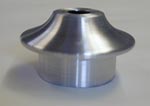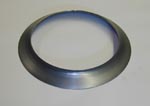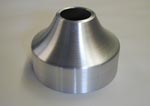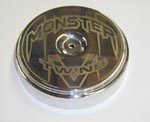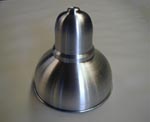Our Process
Metal Spinning…Ancient yet Ageless
Metal spinning is considered one of the world’s oldest art forms, dating back to the ancient Chinese potter’s wheel. Today, as a manufacturing process, it is a practical, cost-effective and precise method of production. Its established niche as the process of choice for prototype and short runs of cylindrical and symmetrical shapes is expanding as longer runs, computerization and other factors point to its use.
Metal spinning is an exception to the conventional economic principles governing many other metalforming techniques. Forming processes usually require powerful devices and heavy-duty tooling built to precise specifications. Given the costs involved, high volumes often are required to justify the initial investment.
On the other hand, metal spinning is a flexible, economical process suitable to prototype, short, medium and long production runs. It can produce a wide variety of hollow parts in differing shapes thicknesses without sacrificing the benefits of metalforming, which include a fully-worked, compacted grain structure.
Moreover, metal spinning is not defined by a series of mathematical laws and relationships as are other manufacturing processes. There are however, several interrelated process variables that govern important quality considerations, including exactness of shape and dimension, wall thickness, surface structure, finish, etc. Machinery has changed over the years, but the basic premise of what happens during the spinning process, and how it is accomplished has not. Many of the original basic calculations—such as working thickness out over a pass—were worked out in Germany. They have no known basis in scientific fact but they work…it’s purely empirical.
Because of the many relationships involved, hands-on metal spinning takes about 10 years to master.
Modern spinning machines permit the selection of ideal process variables, including slide movement, number of work rollers necessary and a controlled predicable work rate.
Metal spinning tooling is simple. Wooden or steel mandrels, which possess the identical shape of the finished part, are usually all that is required. Even so, the dimensional accuracy achieved by the process usually negates the need for further operations.
During the process, a disc blank is clamped against the spinning chuck by a tailstock-mounted pressure pad. Driven by this contact the blank starts to rotate. The roller, which is controlled on two axes progressively forms the blank until the metal takes on the finished shape of the mandrel, or spinning chuck.
The metal becomes workable adjacent to the contact point between the roller and the blank. Here tangential compressive stresses overlap radial tensile stresses. This relationship results in the wall thickness remaining almost constant throughout the process.
Secondary operations such as beading or profiling many times can be performed in the original setup. To accomplish this, a variety of form rollers, trimming wheels and turning tools are available to be fitted to quick-acting tool posts.
Metal Spinning Benefits
When compared to other processes, spinning provides several advantages.
- Short turnaround due to tooling methods.
- Flexibility in tooling, depending on volume, tolerance and capability needed in the part.
- Spinning allows the designer and engineer to obtain function and performance as needed. Tolerances can be adjusted as necessary.
- Ease of design changes—especially if changes are dimensionally smaller—since the original tool can be machined as needed. Tooling cost is less due to its simplicity. The tool is machined from steel, maple block or composites.
- The process actually improves the raw material metallurgically by realigning grain structures. Tensile strength can be improved allowing thinner materials to be used.
- Typical lead times for finished parts are generally shorter than lead times for just the tooling with other processes.

